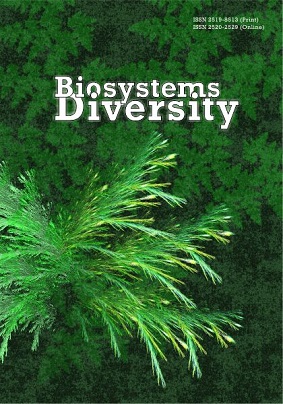Ecological-climatic characteristics of the flora of a floodplain landscape in Southeastern Europe
Ecological-climatic characteristics of the flora of a floodplain landscape in Southeastern Europe
Author(s): B. A. Baranovski, L. Karmyzova, N. O. Roshchyna, I. Ivanko, O. G. KarasSubject(s): Geography, Regional studies, Agriculture, Energy and Environmental Studies, Human Ecology, Environmental interactions
Published by: Дніпропетровський національний університет імені Олеся Гончара
Keywords: valley-terrace landscape; floodplain; forest plant communities; ecomorphs; rare plant species; adventive species;
Summary/Abstract: Floodplain ecosystems take on the role of active areas of biodiversity and provide many “ecosystem services”, as evidenced by a number of European scientific references. A biodiversity analysis of river floodplains in six European countries within the temperate zone has shown that the floodplains are habitats with a high-level of structural and functional dynamics. The level of their conservation reflects the floristic diversity of forest territories, which is especially important for subarid areas. Recently, a comparison of bioecological characteristics of flora in floodplain forest areas and treeless territories was conducted on the floodplain landscapes of a subarid region of Europe. The valley-terraced landscape of the Samara River, a tributary of the Dnieper can serve as a reference site of native plant complexes of subarid territory in Eastern Europe. Despite long-term anthropogenic transformation, the landscape has retained a significant phytodiversity level. The flora of the Samara River area includes 887 plant species. Of these, 177 species belonging to the rare and endangered categories. The floodplain landscape is the richest in species and most diverse part of this complex. The flora of the Samara floodplain includes 728 species (including 132 rare ones), of which 631 grow in forest communities, and 487 – in anthropogenically transformed, treeless floodplain areas. As part of the forest flora, the number of tree and shrubby species, scyophytes, hygrophytes, and megatrophs significantly increases compared to treeless sites, and the number of ruderal plant species decreases. The floristic composition of the floodplain forests of the subarid region is much richer and more diverse than the flora of the treeless floodplain areas, and this should encourage measures for their protection and restoration. Afforestation of floodplain territories within the steppe zone of Ukraine should be a priority in comparison with other landscapes. For the protection of the flora studied, a scientific justification for creating the National Park "Samara Bor" was prepared. Under the conditions of anthropogenic and climatic impact, this article is of great global importance for attracting the attention of specialists, authorities and society to the protection and restoration of biodiversity in the most valuable landscapes.
Journal: Biosystems Diversity
- Issue Year: 28/2020
- Issue No: 1
- Page Range: 98-112
- Page Count: 15
- Language: English

